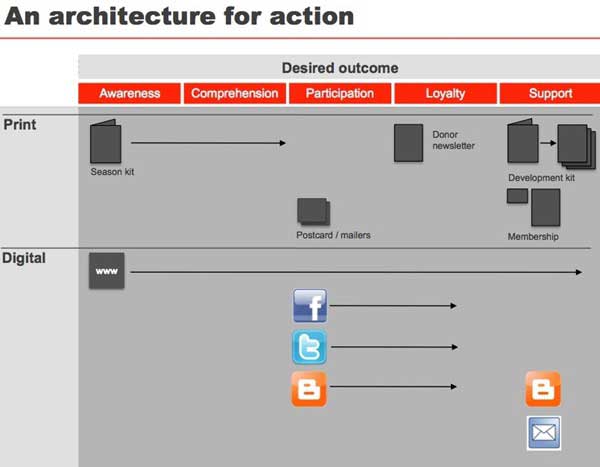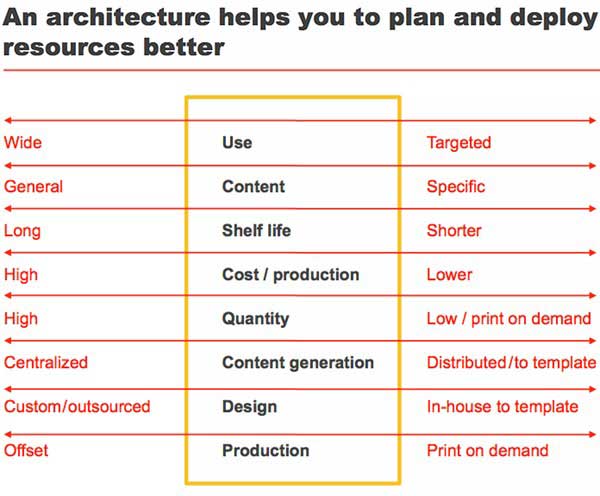You've done your homework and designed a strategic brand program. You've found insight through research, learned what makes your constituents tick, established a strong brand foundation, developed a framework for messages, and evolved a system for visual expression—all necessary to help your organization realize its goals and vision.
Now it's time to build.
An Architecture of Action
So how do you translate your planning and strategy into tactics that drive desired outcomes?
Although you can define your brand in a corner conference room, it doesn't really exist unless your constituents "get it."
For that to happen, you need communications—both outbound and inbound, articulated and acted out. And those communications must address the needs and opportunities presented by target communities; they must help people see their personal brand in the context of your corporate one; and they must get the right information to the right people, in the right format, at the right cost, at the right time.
A "communications architecture" is your best tool for planning and then executing the communications most likely to achieve those goals—and eliminating the ones that aren't.
It's a tool that helps you set priorities around channels and media, consider resources (people, time, and money), rationalize production values, and match tactical objectives to constituencies.
Because an architecture helps everyone plan communications that complement one another (to build the brand) while ensuring you'll have the needed vehicles to achieve tactical goals, it also helps insulate you from the whims and "irrational" demands of your colleagues (point to the handy architecture!) and decreases the need for crazed fire drills.
Most important, though, an architecture helps you engage: It outlines where and how customers will see, hear, and interact with your brand, so that every communication, conversation, and connection contributes to a larger brand image people understand and believe in.
Your brand is a mosaic, and every tile matters. You place some tiles, and some are tweeted and blogged by others. A solid communications architecture helps ensure the proper context for all your brand interactions. It's an important way to retain a sense of control.
Crafting a Communications Architecture
Awareness > Comprehension > Participation > Loyalty > Support/Advocacy
Your constituents all sit at different points on the sales continuum; your goal is to move them along that continuum by communicating appropriately at each point.
If, for instance, you overcommunicate around participation ("buy x product," "come to y event") while undercommunicating around comprehension ("here's how we can help you"), your target customers won't have enough understanding to do what you ask them to do. They'll be not only unlikely to buy but also likely to be turned off.
Your customers need to be moved to participate, not told to.
So, given your brand program, goals, and opportunities, which communications will help build general awareness? Which help constituents understand you and your offerings? Which move people to participate in programs or buy your products? And so on.
Start building your communication architecture by plotting those current and aspirational communications into a matrix: Put your desired outcomes—where you'd like to "move" people to—on the x axis; and put your medium or production values on the y axis.

A communication architecture helps you plan which communications,
when, to whom, at what cost, to achieve what ends
You also want to consider medium and production values. Which print communications should be high-quality offset and which digitally demand-printed?
It makes sense, for example, to spend some money on a high-production-value awareness piece if it's likely to have a long shelf life and speak to a wide audience. But longevity requires content that won't date easily, and wide audience appeal demands general or high-level content.
On the other hand, you might consider digitally printing an invite for your next conference session, or perhaps create an electronic invite and forgo printing costs altogether.

Planning the right mix of communications means
integrating needs, possibilities, and resources
Similarly, you want to invest in the infrastructure of your website and have it last for years. But you want a quick, inexpensive way to swap out features.
An Architecture for Social Media
Of course, you need more than an overview piece, invites, and a website. The ever-widening array of social-media options needs to be planned, integrated, and deployed so that they, too, make best use of resources, reinforce other efforts, and help decrease the distance between your organization and the people who matter most to you. Not carefully planning for those new tools can lead to rapid brand diffusion and loss of control.
Article Series:
Branding in the Age of Social
Your customers—your communities—have new expectations. They want to (actually!) interact with your organization. They want to know what they want to know—when they want to know it. And, as always, they want to know, and feel, how your organization and its brand align with their personal brands and values.
Achieving that alignment has always been critical to effective brand-building. But it's not enough to design a new logo, snappy tagline, brochures, and website (it never was).
Brand-building in this social age—social branding—goes beyond social, or even digital, media. It's about deliberately aligning your and your constituents' expectations and values, not just in communications but at the core of how your organization sees and organizes itself, how it behaves, and how it delivers on its core purpose.
In this article series, we'll outline the seven pieces of the social branding process and how each step can work hard to maximize the connections between not only you and your customers but also the connections between your customers and their trusted friends and peers (in other words, to maximize "social capital").
The series culminates with an online seminar in April, "7 Steps to Take Your Brand Social... and Still Be in Control," where you'll learn how to evaluate and develop your strategy for building your social brand.
—Tamsen
McMahon
Director of Strategic Initiatives
Sametz Blackstone Associates
Because social-media communications are about providing opportunities for people to home in on what they want to connect with, a monolithic social-media presence may not be the best route.
For example, a university active in social media might maintain separate outposts for prospective students, alumni, faculty, and more—each with specific content for a specific audience in service of a desired outcome (again: awareness, comprehension, participation... support).
A media company might have Twitter feeds for particular content areas, personalities, and programs. A mutual fund company might have a blog that's industry focused and a Twitter feed that's product focused. And so on.
The goal: Be where you need to be.
What's the right mix for you? Create a social-media communications architecture that gives people the opportunity to connect to specific programs, products, and personalities—and share with like-minded individuals.
Deliver content that equips brand advocates and drives specific, desired outcomes. If you don't know with whom you're trying to connect or what the goal of a particular social-media outpost is, it's unlikely you'll achieve positive results.
Hitting the Streets
Because your brand doesn't have traction—and doesn't even exist—until it's internalized by those important to your success, connecting to constituents in ways that work for them is vitally important.
A communications architecture—one that considers print, digital, and social-media communications in terms of both desired outcome and production-value and resource requirements—is the road map by which you get your brand "out there."
A good communications architecture helps set priorities, makes the most of resources, reduces redundant communications, gives you a measuring stick by which to reject misinformed communications requests, and helps you meet people where they are—so that you can move forward together.



